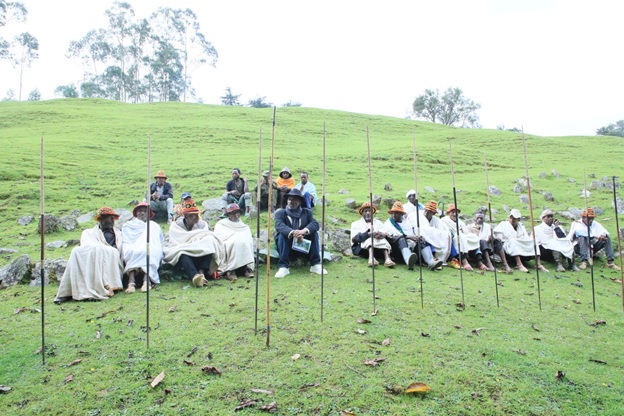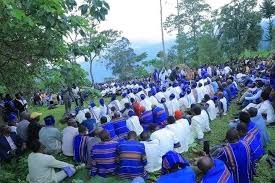
In examining a given nation, the cultural asset of that nation takes the greatest share. African people have been unique in preserving their indigenous cultures for centuries. These artistic practices did carry the potential, efficacy and intelligence of the people. In the cultural portrayal of a given nation, the philosophy, belief, and mental excellence of the people are mirrored through it. Thus, since these artistic practices are exhibited as per the identity and context of the holders, it is logical to say that these cultures are also opportunities to be used for transforming and advancing the people.
Ethiopia embraces a variety of cultural identities that coexist with harmony and peaceful cooperation. Among these cultures, Gamo people who are located in the southern part of the region are the ones that have their own impressive culture and values. In the area where one needs to raise the culture of these people, Dubusha takes the highest share.
Dubusha is the most adored and respected notion in the people of Gamo. It is the term that conveys the who of the people’s identity and culture. Everything in the area is connected with it. Thus, what does it mean? …was the interest of The Ethiopian Herald crew? We ran to the area and contacted the scholars and elders. We also noticed some practices in person.
Tafesse Welea, Community Service Coordinator at Social Science and Humanities College of Arba Minch University, is a researcher who has been studying the culture of Dubusha and from the culture too. He had an exclusive interview with The Ethiopian Herald.
I picked up the term Dubusha and asked him to explain it to begin our conversation. He said, “Dubusha did mean meeting. The coming together of people to discuss any issue which can be done anywhere is Dubusha. But in the issues that commonly concern the given Derie or culturally portioned region, the meeting place is already assigned by the people. And that place is called Dubusha.” The researcher further explained that the people of Gamo had been administered by the cultural and indigenous knowledge of the elders that they received it from generations.
The background of the Indigenous knowledge that these people cultured to peacefully administer their regions or Deries is the orally transmitted mythology. As Tafese said, this mythology dictated that when the people of Gamo quarrel and suspicion occurs among themselves, then the Holy Spirit send a rule and regulation to the people to be respected. It affirms that the community should live peacefully and respectfully; otherwise, something bad could happen to them and their generations. This mythology then excels from generation to generation. Though the tendency and the magnitude of its application are slightly varied across Deries, the major cultural rudiments are still prevailing in the community as a whole.
“Dubusha, at the given community is going to be prepared based on some necessities. These are the place should be positioned on the top surface of the given village.” As Tafesse explained the reason for making this is to make it visible to the community. In addition to that, if it is placed on the top area, it is possible to view the natural settings that are very relevant during the oath process of the suspect who finally gets up there. That is at this top place it is possible to see the mountain, the graves, the trees, and the elders that could face the person in that setting. The next thing to be considered is the place should be eclectic and plain. This is deliberately done to make it comfortable and accommodating.
Dubusha can happen at the family level. The pillar of the house is the husband or the elder male section in the family. Thus, this man can bring the family members together and discuss issues that happened in the house or could narrate about the culture to the family. This is Dubusha. But if there is a community -concerning issue then it could be taken into the meeting place Dubusha. This culturally believed judgment place is assumed a sacred place. Thus it is a highly respected and preserved area.
Dubusha in a given Derie or cultural region is recognized as the place where fair and sound justice is delivered for the community equally. At this type of Dubusha, lots of cultural events take place. Since the people are administered by cultural leaders or Halekas and Hudugas and on top-level Kawos, these power transitions and appointments had been taking place at this place.
Kawo Tadess who is the top leader or king of Deries, told to Herald the following. “Dubusha is the most adored and blessed place in the eyes of Gamo people” as he asserted any case that the community faced in their life, they brought to Dubusha and there are appointed leaders that are responsible for cases as per their subject. Then a responsible leader or Haleka, could try to solve the raised issue after a cautious and fortitude hearing and understanding of the issue from the community. Though there are top leaders over the given Haleka, no one could try to interfere in the power exercising right of the given leader.
While I was at Dita to contact the cultural leader of the area, I was directed to the Culture and Communication Office of the area by Zone department. When I got there, the legal cultural office leader was waiting for me. I talked to him and asked him to call the cultural leader. Then a very old and gorgeous man with cultural decor wearing style and with half metal made stick arrived. In the office, the officer introduced me to him and invited him to sit on the officer’s chair. But this old man refused. I said why. He said, “That is not my chair and responsibility. I have my own place to sit. In this context, I am a customer not a leader at this place.” Then the officer took us out to the area’s meeting place or Dubusha. There, this old man plugs in his stick and sits on the bench made from stone.
Tafesse mentioned that, unlike the modern procedure in courts, cases that happened in the community of Gamo are not expected to have evidence. If there is evidence, it is good and could be used to help the criminal confess his deed. But in the culture of Gamo people, the steps they follow to solve problems and make judgments are quite different. For whatever wrong did happen in the area, the suspect is simply called and asked for the issue.
In Gamo zone even before the legal procedure was seen in court, the people were managed by their indigenous knowledge and culture. This cultural administration had its own system and hierarchy. Issues are uniquely headed by a particular leader or Haleka. For instance as the approached elders assured there is one leader or Haleka that is responsible for the preservation and management of Dubusha, and there is another Haleka that takes care of the preservation of indigenous plants and so on. On top of them, there is a top leader called Huduga. All the Halekas take care of their responsibility. If things go beyond their scope, they could bring it to Dubusha and call Huduga for top decision. The Hudugas again are led by a top leader called Kawo. This Kawo is responsible for heading more Deries or Hudugas. Though he is the top leader, he never interferes with the responsibilities of Hudugas. He could avail himself if there were cases that needed his confirmation.
This hierarchy and cultural administration have been there in the area for centuries. Thus, the people are very respectful and cooperative when approached by their elders. Therefore, this asset could be used as an opportunity to ensure togetherness and complementarity between people in the country and the continent too. Our indigenous identity, I believe is the best way to achieve our prosperity goal.
BY MEKDES TAYE (PhD)
THE ETHIOPIAN HERALD SUNDAY EDITION 27 OCTOBER 2024




